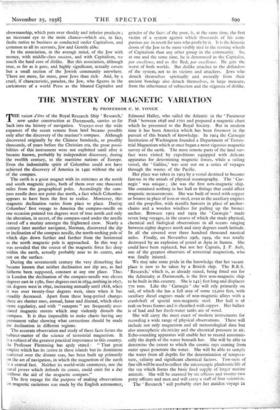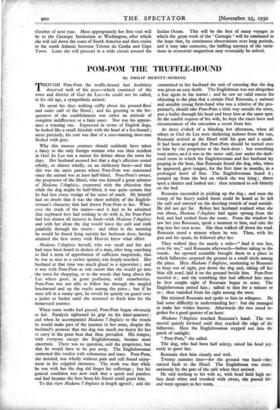THE MYSTERY OF MAGNETIC VARIATION
By PROFESSOR C. M. YONGE
The earth is a great magnet with its extremes at the north and south magnetic poles, both of them over one thousand miles from the geographical poles. Accordingly the com- pass needle does not point due north, a fact which Columbus appears to have been the first to realise. Moreover, this magnetic declination varies from place to place. During Columbus' first voyage to America the compass-needle on one occasion pointed ten degrees west of true north and only the alteration, in secret, of the compass-card under the needle staved off a mutiny amongst the frightened crew. Nearly a century later another navigator, Norman, discovered the dip or inclination of the compass needle, the north-seeking pole of which dips down further and further from the horizontal as the north magnetic pole is approached. In this way it was revealed that the source of the magnetic force lies deep within the earth, actually probably near to its centre, and not on the surface.
During the seventeenth century the very disturbing fact became known that neither declination nor dip are, as had hitherto been supposed, constant at any one place. Thus in London the declination of the compass-needle was eleven degrees east in 158o, four degrees east in 1634, nothing in 1657, six degrees west in 1692, increasing annually until 1818, when it was over twenty-four degrees west, since when it has steadily decreased. Apart from these long-period changes there are shorter ones, annual, lunar and diurnal, which show more regularity, and with " sunspots " are frequently asso- ciated magnetic storms which may violently disturb the compass. It is thus impossible to make charts having any permanent value showing what corrections should be made for declination in different regions.
The accurate observation and study of these facts forms the subject-matter of the science of terrestrial magnetism. It is a subject of the greatest practical importance to this country. As Professor Flemming has aptly stated : " That great empire which has its centre in these islands but its dominions scattered over the distant seas, has been built up primarily on the art of navigation, in which the magnetism of the earth is a central fact. Neither its world-wide commerce, nor the naval power which defends its coasts, could exist for a day without the aid of the magnetic compass."
The first voyage for the purpose of making observations on magnetic variations was made by. the English astronomer, Edmund Halley, who sailed the Atlantic in the ' Paramour Pink ' between 1698 and 1701 and prepared a magnetic chart which he presented to the Royal Society. But in modern time it has been America which has been foremost in the pursuit of this branch of knowledge. In 1904 the Carnegie Institution of Washington founded a Department of Terres- trial Magnetism which at once began a most vigorous magnetic survey of the earth. The most remote parts of the land sur- face were visited by expeditions equipped with delicate apparatus for determining magnetic forces, while a sailing vessel, the Galilee,' was sent out on a series of voyages through the wastes of the Pacific.
Her place was taken in 1909 by a vessel destined to become famous in the annals of physical oceanography. The ' Car- negie ' was unique ; she was the first non-magnetic ship. She contained nothing in her hull or fittings that could affect magnetic measurements. She was built of wood with copper or bronze in place of iron or steel, even in the auxiliary engines and the propellor, with manilla hawsers in place of anchor- chains and a wooden windlass for pulling up the bronze anchor. Between Igo? and 1929 the ' Carnegie ' made seven long voyages, in the course of which she made physical, chemical and biological observations in all oceans ranging between eighty degrees north and sixty degrees south latitude. In all she covered over three hundred thousand nautical miles. Finally, on November 29th, 1929, she was totally destroyed by an explosion of petrol at Apia in Samoa. She could have been replaced, but not her Captain, J. P. Ault, one of the greatest observers of terrestrial magnetism, who was fatally injured.
We may take some pride in the knowledge that her vacant place is now to be taken by a British ship. The R.R.S. ' Research,' which is, as already stated, being fitted out for the Admiralty at Dartmouth, is the first non-magnetic ship to be built in this country. She is 1421 feet long and displaces no tons. Like the ' Carnegie ' she will rely primarily on sail, of which she has a full area of some 12,000 feet, with auxiliary diesel engines made of non-magnetic alloys with a crankshaft of special non-magnetic steel. Her hull is of teak on brass frames and is sheathed with copper. Her ballast is of lead and her fresh-water tanks are of wood.
She will carry the most exact of modern instruments for recording a wide range of physical observations. These will include not only magnetism and all meteorological data but also atmospheric electricity and the electrical pressure in air. Echo-sounding apparatus will enable her to record automati- cally the depth of the water beneath her. She will be able to determine the extent to which the cosmic rays coming from outer space penetrate the water. She will be able to sample the water from all depths for the determination of tempera- ture,salinity and significant chemical factors. Tow-nets of fine silk will be used to collect the microscopic planktonic life of the sea which forms the basic food supply of larger marine animals. She will be manned by six officers and twenty-two petty officers and men and will carry a staff of four scientists. The ' Research' will probably start her taaiden voyage in October of next year. Most appropriately her first visit will be to the Carnegie Institution at Washington, after which she will sail down the coast of South America and then cruise in the south Atlantic between Tristan da Cunha and Cape Town. Later she will proceed in a wide circuit around the Indian Ocean. This will be the first of many voyages in which the great work of the ' Carnegie ' will be continued in the hope that, by continuous observations over long periods, and it may take centuries, the baffling mystery of the varia- tions in terrestrial magnetism may eventually be solved.















































 Previous page
Previous page